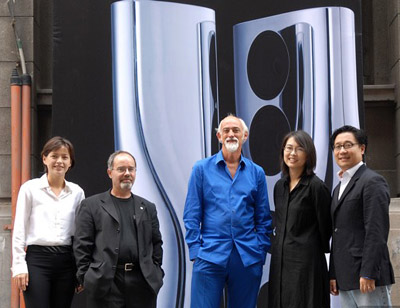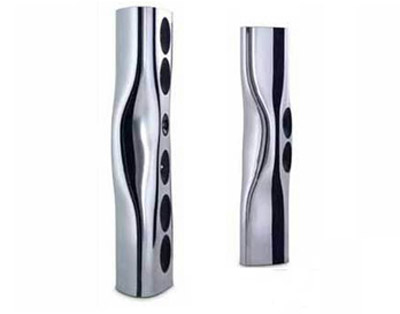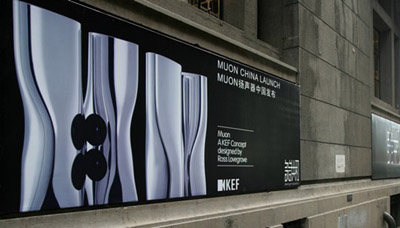Perhaps the most extraordinary audio speaker ever conceived, the two-meter-high "Muon" has started its world tour that has included such avant-garde cities as Milan and London and now the bustling city of Shanghai.
Produced by British high-end audio brand KEF, this unparalleled art form is appropriate for 21st-century living, but only 100 pairs have been made. One pair is currently on display at Design Republic on Shanghai's Bund Five. The exhibit provides a special opportunity for local connoisseurs to see, listen to and feel this 1.038 million-yuan (US$137,962) "breakthrough" in the hi-fi industry.
The mastermind behind this technology-driven design speaker is Ross Lovegrove, a materials and technology-led industrial designer, and to those who know his work, a visionary. The final form of the loudspeaker results from a careful convergence between Lovegrove's design aesthetics and the physics of sound.
This avant garde thinking creator was recently in town for the Muon China Launch and spoke to Shanghai Daily about his great achievement, Muon, as well as his passion, philosophy and holistic approach to design.
"We are living in the fabulous age between things like a little iPod which gives incredible portability of sound but also objects like Muon - the opposite," the 49-year-old Welsh-born designer says. "Muon has a certain concept of infinity or endurance, which shows the power of the foam but the gentleness of the sound. When it is played at its lowest, it is so emotional but powerful, like a big man talking to you in a very gentle way.
"My design product describes a philosophy of the foam. It is not just a foam for the sake of design," Lovegrove says. "When you stand next to Muon, you feel alive in a powerful human way. It's more than a superior speaker and more like an investment in art. Art is the magic component which gives something extra value beyond engineering."
With a polished aluminum finish, the speakers beautifully reflect everything around them. The concept uses malleable sheets of heated aluminum to achieve otherwise impossible shapes. The process by which they were conceived meant that, in effect, Lovegrove was sculpting the sound by "skinning" the technology with purposeful form.
When asked about his reason for using aluminum, Lovegrove says the material is recyclable and modern. But the real reason is that the six-millimeter-thick, heavily dampened aluminum shell provides a totally rigid structure that minimizes any sound-distorting vibrations.
For him to commit time and energy to a project it must have a progressive element to it, whether aesthetic, technological, or functional - or a combination of all three. Muon is the perfect example of these concerns.
First and foremost, Lovegrove is a materials-led designer whose 24-year career has been informed and galvanized by the form-inspiring and poetic qualities of materials and manufacturing processes.
Beyond this, forms and structures found in the natural world have profoundly influenced him.
"I use the material in the right way. There is a relationship between material and function which is super important to me," he says. "We are using materials in an intelligent way and I want to be part of them. Nothing I design is ever retro but it's defining the environment and the age we live in."
Working with fluid shapes and informed by persuasive new technologies, Lovegrove's work is emerging as that of a benchmark designer for the 21st century.
He began his career with the industrial design consultancy Frog Design in Germany in the early 1980s and inaugurated his own London-based industrial design practice, Studio X, in the early 1990s.
As one of the top five industrial designers in the world, his products range from the walkmans for Sony, iMac for Apple, to watches, kitchenware, the outdoor lighting and airplane interiors for clients including British Airways, Kartell, Japan Airlines and Issey Miyake.
His work features in permanent collections in design museums globally including the Museum of Modern Art in New York and the Design Museum in London. In 2005, he was awarded the World Technology Award by Time and CNN.
Throughout his career, Lovegrove has worked on projects for varied industries. He understands the form and is enjoying the digital age to create it. Known as "Captain Organic," his work is organic in form and inspired by nature.
"I practice 'Organic Essentialism,' in which 'organic' means a way of thinking, the attitude to material and foam; 'essentialism' means nothing more than you need," Lovegrove says.
Keenly aware of the environmental impact of over-consumption, he is trying to do things with minimum resources but at the same time achieve the maximum civilizing effects.
Be it a bottle, a chair, or a car, each object he creates is reduced to its essential elements, combining state-of-the-art materials with sculptural organic forms.
By learning from nature and its evolutionary adaptations Lovegrove sees that we can devise design solutions that are not only better suited to the human condition, but also more sustainable.
His underlying humanistic concerns imbue his work with a hopeful optimistic belief in the future.
"When you see my work for different brands, you always see me and it doesn't matter who I work for. I am working on a level where I'm bringing more awareness to the beauty and quality around us. I'm excited about what opportunities I will get tomorrow to contribute to the world."
Lovegrove's favorite personal motto is: "It's only the future if it can't be made."
(Shanghai Daily September 18, 2007)




